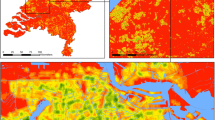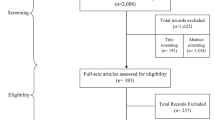Abstract
Objectives
The aim of this study was to investigate which GIS-based measures of walkability (density, land-use mix, connectivity and walkability indexes) in urban and suburban neighbourhoods are used in research and which of them are consistently associated with walking and cycling for transport, overall active transportation and weight-related measures in adults.
Methods
A systematic review of English publications using PubMed, Science Direct, Active Living Research Literature Database, the Transportation Research Information Service and reference lists was conducted. The search terms utilised were synonyms for GIS in combination with synonyms for the outcomes.
Results
Thirty-four publications based on 19 different studies were eligible. Walkability measures such as gross population density, intersection density and walkability indexes most consistently correlated with measures of physical activity for transport. Results on weight-related measures were inconsistent.
Conclusions
More research is needed to determine whether walkability is an appropriate measure for predicting weight-related measures and overall active transportation. As most of the consistent correlates, gross population density, intersection density and the walkability indexes have the potential to be used in planning and monitoring.

Similar content being viewed by others
References
Bauman A, Bull F (2007) Environmental correlates of physical activity and walking in adults and children: a review of reviews. National Institute of Health and Clinical Excellence, London
Berke EM, Koepsell TD, Moudon AV, Hoskins RE, Larson EB (2007) Association of the built environment with physical activity and obesity in older persons. Am J Pub Health 97(3):486–492. doi:10.2105/AJPH.2006.085837
Bodea TD, Garrow LA, Meyer MD, Ross CL (2008) Explaining obesity with urban form: a cautionary tale. Transp Res Part A Policy Pract 35:179–199
Boer R, Zheng Y, Overton A, Ridgeway GK, Cohen DA (2007) Neighborhood design and walking trips in ten US metropolitan areas. Am J Prev Med 32:298–304
Brown BB, Yamada I, Smith KR, Zick CD, Kowaleski-Jones L, Fan JX (2009) Mixed land use and walkability: variations in land use measures and relationships with BMI, overweight, and obesity. Health Place 15:1130–1141
Brownson RC, Hoehner CM, Day K, Forsyth A, Sallis JF (2009) Measuring the built environment for physical activity: state of the science. Am J Prev Med 36(4 Suppl):S99–S123
Cao X, Mokhtarian PL, Handy SL (2009) Examining the impacts of residential self-selection on travel behaviour: a focus on empirical findings. Transp Rev 29(3):359–395. doi:10.1080/01441640802539195
Cerin E, Leslie E, Toit Ld, Owen N, Frank LD (2007) Destinations that matter: associations with walking for transport. Health Place 13(3):713–724. doi:10.1016/j.healthplace.2006.11.002
Chatman DG (2009) Residential choice, the built environment, and nonwork travel: evidence using new data and methods. Environ Plan A 41(5):1072–1089
Coombes E, Jones AP, Hillsdon M (2010) The relationship of physical activity and overweight to objectively measured green space accessibility and use. Soc Sci Med 70(6):816–822. doi:10.1016/j.socscimed.2009.11.020
Effective Practice Institute UoA The GATE Notes: a generic appraisal tool for epidemiology. http://user.meduni-graz.at/andrea.berghold/EBM/Gate_Notes.pdf; Last accessed 15th October 2011
EPHPP (2009a) Quality assessment tool for quantitative studies. Effective public health practice project, http://www.ephpp.ca/PDF/Quality%20Assessment%20Tool_2010_2.pdf; Last accessed 13th January 2012
EPHPP (2009b) Quality assessment tool for quantitative studies dictionary. Effective public health practice project, http://www.ephpp.ca/PDF/QADictionary_dec2009.pdf; last accessed 13th January 2012
Ewing R, Cervero R (2010) Travel and the built environment. J Am Plann Assoc 76(3):265–294
Feng J, Glass TA, Frank CC, Stewart WF, Schwartz BS (2009) The built environment and obesity: a systematic review of the epidemiological evidence. Health Place 16:175–190. doi:10.1016/j.healthplace.2009.09.008
Forsyth A, D’Sousa E, Koepp J, Oakes JM, Schmitz KH, Zimmerman J, Rodriguez D, Song Y (2006) Environment and physical activity. GIS Protocols Version 4.0. University of Minnesota, Metropolitan Design Center
Forsyth A, Oakes JM, Schmitz KH, Hearst M (2007) Does residential density increase walking and other physical activity? Urb Stud 44(4):679–697. doi:10.1080/00420980601184729
Forsyth A, Hearst M, Oakes JM, Schmitz KH (2008) Design and destinations: factors influencing walking and total physical activity. Urb Stud 45(9):1973–1996. doi:10.1177/0042098008093386
Forsyth A, Oakes JM, Lee B, Schmitz KH (2009) The built environment, walking, and physical activity: is the environment more important to some people than others? Transp Res Part D Transp Environ 14:42–49
Frank L, Engelke P, Schmid T (2003) Health and community design. The impact of the built environment on physical activity. Island Press, Washington
Frank LD, Andresen MA, Schmid TL (2004) Obesity relationships with community design, physical activity, and time spent in cars. Am J Prev Med 27:87–96
Frank LD, Schmid TL, Sallis JF, Chapman J, Saelens BE (2005) Linking objectively measured physical activity with objectively measured urban form: findings from SMARTRAQ. Am J of Prev Med 28(2 Suppl 2):S117–S125. doi:10.1016/j.amepre.2004.11.001
Frank LD, Sallis JF, Conway TL, Chapman JE, Saelens BE, Bachman W (2006) Many pathways from land use to health: associations between neighborhood walkability and active transportation, body mass index, and air quality. J Am Plann Assoc 72:75–87
Frank LD, Saelens BE, Powell KE, Chapman JE (2007) Stepping towards causation: do built environments or neighborhood and travel preferences explain physical activity, driving, and obesity? Soc Sci Med 65(9):1898–1914. doi:10.1016/j.socscimed.2007.05.053
Frank LD, Kerr J, Sallis JF, Miles R, Chapman JE (2008) A hierarchy of sociodemographic and environmental correlates of walking and obesity. Prev Med 47:172–178
Frank LD, Kerr J, Saelens BE, Sallis JF, Glanz K, Chapman JE (2009a) Food outlet visits, physical activity and body weight: variations by gender and race-ethnicity. Br J Sports Med 43:124–131
Frank LD, Sallis JF, Saelens BE, Leary L, Cain K, Conway TL, Hess PM (2009b) The development of a walkability index: application to the neighborhood quality of life study. Br J Sports Med. doi:10.1136/bjsm.2009.058701
Frumkin H, Frank L, Jackson R (2004) Urban sprawl and public health. Island Press, Washington
Giles-Corti B, Timperio A, Bull F, Pikora T (2005) Understanding physical activity environmental correlates: increased specificity for ecological models. Exerc Sport Sci Rev 33(4):175–181
Huang L, Stinchcomb DG, Pickle LW, Dill J, Berrigan D (2009) Identifying clusters of active transportation using spatial scan statistics. Am J Prev Med 37:157–166
Kitamura R, Mokhtarian PL, Laidet L (1997) A micro-analysis of land use and travel in five neighborhoods in the San Francisco Bay Area. Transportation 24:125–158
Lee C, Moudon AV (2006) Correlates of walking for transportation or recreation purposes. J Phys Act Health 3:S77–S98
Leslie E, Coffee N, Frank L, Owen N, Bauman A, Hugo G (2007) Walkability of local communities: using geographic information systems to objectively assess relevant environmental attributes. Health Place 13(1):111–122. doi:10.1016/j.healthplace.2005.11.001
Li F, Harmer PA, Cardinal BJ, Bosworth M, Acock A, Johnson-Shelton D, Moore JM (2008) Built enviornment, adiposity, and physical activity in adults aged 50–75. Am J Prev Med 35:38–46
Li F, Harmer PA, Cardinal BJ, Bosworth M, Johnson-Shelton D, Moore JM, Acock A, Vongjaturapat N (2009) Built environment and 1 year change in weight and waist circumference in middle-aged and older adults. J Epidemiol 196(4):401–408
Liberati A, Altman DG, Tetzlaff J, Mulrow C, Gotzsche PC, Ioannidis JP, Clarke M, Devereaux PJ, Kleijnen J, Moher D (2009) The PRISMA statement for reporting systematic reviews and meta-analyses of studies that evaluate health care interventions: explanation and elaboration. J Clin Epidemiol 62(10):e1–e34
Lopez RP (2007) Neighborhood risk factors for obesity. Obesity 15(8):2111–2119
McGinn AP, Evenson KR, Herring AH, Huston SL, Rodriguez DA (2007) Exploring associations between physical activity and perceived and objective measures of the built environment. J Urb Health 84(2):162–184. doi:10.1007/s11524-006-9136-4
Oakes JM, Forsyth A, Schmitz KH (2007) The effects of neighborhood density and street connectivity on walking behavior: the Twin Cities walking study. Epidemiol Perspect Innov 4:16
Owen N, Humpel N, Leslie E, Bauman A, Sallis JF (2004) Understanding environmental influences on walking. Review and research agenda. Am J Prev Med 27(1):67–76. doi:10.1016/j.amepre.2004.03.006
Owen N, Cerin E, Leslie E, duToit L, Coffee N, Frank LD, Bauman AE, Hugo G, Saelens BE, Sallis JF (2007) Neighborhood walkability and the walking behavior of Australian adults. Am J Prev Med 33(5):387–395. doi:10.1016/j.amepre.2007.07.025
Owen N, De Bourdeaudhuij I, Sugiyama T, Leslie E, Cerin E, Van Dyck D, Bauman A (2010) Bicycle use for transport in an Australian and a Belgian city: associations with built-environment attributes. J Urb Health 87(2):189–198. doi:10.1007/s11524-009-9424-x
Papas MA, Alberg AJ, Ewing R, Helzlsouer KJ, Gary TL, Klassen AC (2007) The built environment and obesity. Epidemiol Rev 29:129–143. doi:10.1093/epirev/mxm009
Petticrew M, Roberts H (2008) Systematic reviews in the social science: a practical guide. Blackwell, Malden
Pouliou T, Elliott SJ (2010) Individual and socio-environmental determinants of overweight and obesity in Urban Canada. Health Place 16(2):389–398. doi:10.1016/j.healthplace.2009.11.011
Rundle A, Diez Roux AV, Freeman L, Miller D, Neckerman K, Weiss CC (2007) The urban built environment and obesity in New York City: a multilevel analysis. Am J Health Promot 21:326–334
Rundle A, Neckerman KM, Freeman L, Lovasi GS, Purciel M, Quinn J, Richards C, Sircar N, Weiss C (2009) Neighborhood food environment and walkability predict obesity in New York City. Environ Health Perspect 117(3):442–447
Saelens BE, Handy SL (2008) Built environment correlates of walking: a review. Med Sport Sci 40(7 Suppl):S550–S566
Saelens BE, Sallis JF, Black JB, Chen D (2003a) Neighborhood-based differences in physical activity: an environment scale evaluation. Am J Public Health 93(9):1552–1558
Saelens BE, Sallis JF, Frank LD (2003b) Environmental correlates of walking and cycling: findings from the transportation, urban design, and planning literature. Ann Behav Med 25(2):80–91
Sallis JF (2009) Measuring physical activity environments: a brief history. Am J Prev Med 36(4 Suppl):S86–S92. doi:10.1016/j.amepre.2009.01.002
Sallis JF, Glanz K (2009) Physical activity and food environments: solutions to the obesity epidemic. Milbank Q 87(1):123–154. doi:10.1111/j.1468-0009.2009.00550.x
Sallis JF, Frank LD, Saelens BE, Kraft MK (2004) Active transportation and physical activity: opportunities for collaboration on transportation and public health research. Transp Res Part A 38:249–268. doi:10.1016/j.tra.2003.11.003
Sallis JF, Saelens BE, Frank LD, Conway TL, Slymen DJ, Cain KL, Chapman JE, Kerr J (2009) Neighborhood built environment and income: examining multiple health outcomes. Soc Sci Med 68(7):1285–1293. doi:10.1016/j.socscimed.2009.01.017
Scott MM, Dubowitz T, Cohen DA (2009) Regional differences in walking frequency and BMI: what role does the built environment play for Blacks and Whites? Health Place 15:897–902
Smith KR, Brown BB, Yamada I, Kowaleski-Jones L, Zick CD, Fan JX (2008) Walkability and body mass index density, design, and new diversity measures. Am J Prev Med 35(3):237–244. doi:10.1016/j.amepre.2008.05.028
Van Dyck D, Cardon G, Deforche B, Sallis JF, Owen N, De Bourdeaudhuij I (2010a) Neighborhood SES and walkability are related to physical activity behavior in Belgian adults. Prev Med 50(Suppl 1):S74–S79. doi:10.1016/j.ypmed.2009.07.027
Van Dyck D, Cerin E, Cardon G, Deforche B, Sallis JF, Owen N, de Bourdeaudhuij I (2010b) Physical activity as a mediator of the associations between neighborhood walkability and adiposity in Belgian adults. Health Place 16(5):952–960. doi:10.1016/j.healthplace.2010.05.011
WHO (2006) Obesity and overweight. http://www.who.int/mediacentre/factsheets/fs311/en/. Accessed 2 Dec 2012
Zick CD, Smith KR, Fan JX, Brown BB, Yamada I, Kowaleski-Jones L (2009) Running to the store? The relationship between neighborhood environments and the risk of obesity. Soc Sci Med 69(10):1493–1500. doi:10.1016/j.socscimed.2009.08.032
Acknowledgments
Delfien van Dyck was supported by Research Foundation Flanders (FWO) B/09731/01.
Conflict of interest
The authors declare that they have no conflict of interest.
Author information
Authors and Affiliations
Corresponding author
Electronic supplementary material
Below is the link to the electronic supplementary material.
Rights and permissions
About this article
Cite this article
Grasser, G., Van Dyck, D., Titze, S. et al. Objectively measured walkability and active transport and weight-related outcomes in adults: a systematic review. Int J Public Health 58, 615–625 (2013). https://doi.org/10.1007/s00038-012-0435-0
Received:
Revised:
Accepted:
Published:
Issue Date:
DOI: https://doi.org/10.1007/s00038-012-0435-0




